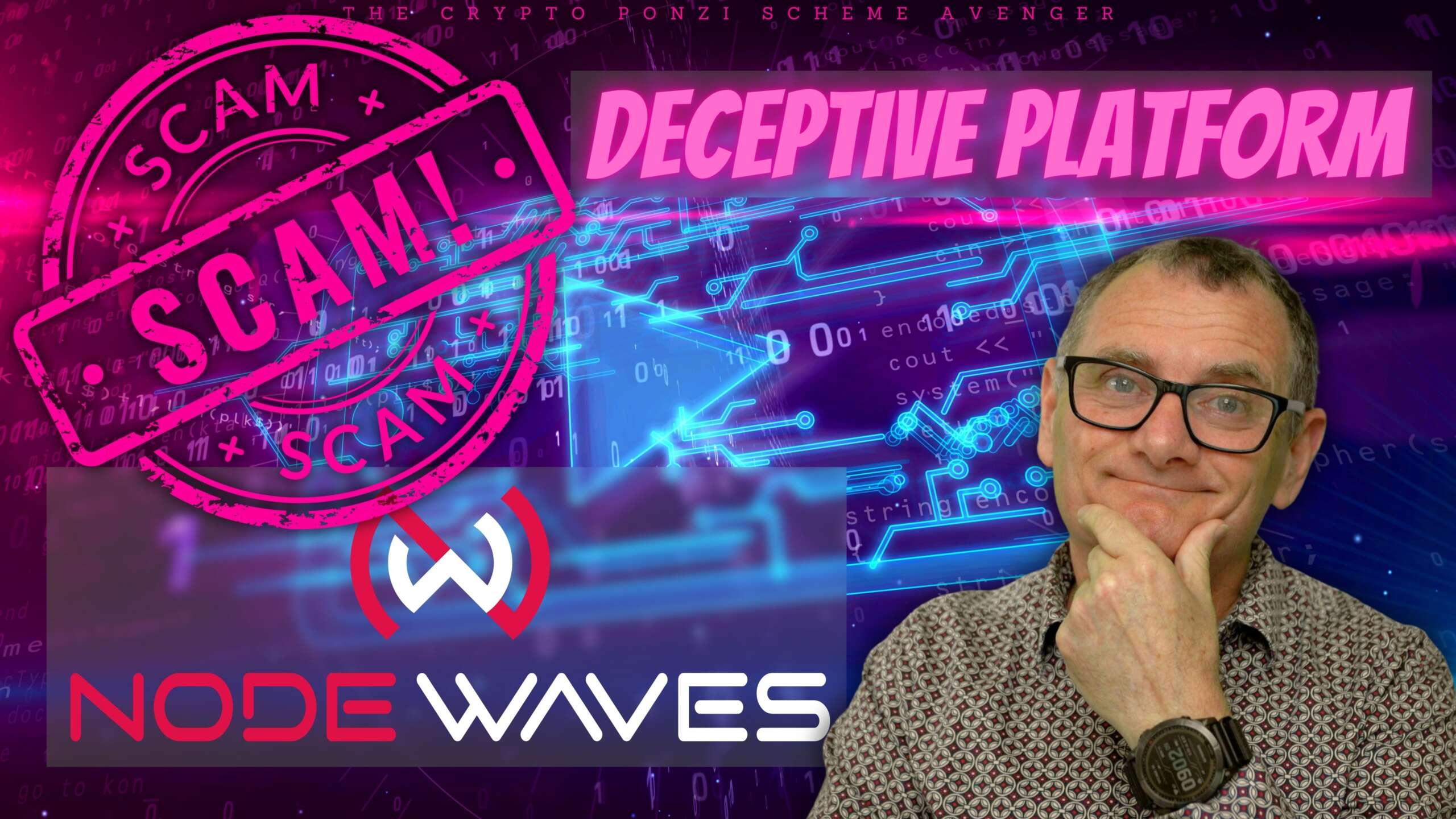Blockchain technology holds immense potential, offering decentralized solutions that empower individuals and enhance industries. But with innovation comes exploitation, and the rise of blockchain scams is a stark reminder that not every project is as promising as it seems.
One such project, Nodewaves, markets itself as a revolutionary ecosystem of nodes, NFTs, and a Move-to-Earn fitness app. At first glance, it appears cutting-edge. However, a closer look reveals a troubling array of red flags that investors cannot afford to ignore.
This blog unpacks the claims and exposes the vulnerabilities of Nodewaves, breaking down the tactics it uses to attract participants and the structural flaws that undermine its legitimacy.
The Nodewaves Red Flags
1. The Illusion of Innovation
Nodewaves brands itself as a blockchain pioneer, using terms like “post-quantum security,” “zkRollups,” and “decentralized governance” to suggest technical sophistication. However, these claims lack substance:
- No Technical Evidence: The project does not provide whitepapers, open-source code, or audits to back its technical claims.
- Misleading Jargon: Buzzwords like “metaverse economy” and “polygon Layer 2 scaling” are sprinkled liberally but fail to explain how the technology is implemented or benefits users.
- Opaque Development: There’s no roadmap or transparent communication about future developments, leaving investors in the dark about the project’s direction.
Nodewaves seems more focused on projecting an image of innovation than delivering genuine blockchain solutions.
2. Pay-to-Play Mechanics
A major red flag lies in Nodewaves’ requirement for participants to purchase node licenses or NFTs to engage with its ecosystem. Early adopters are lured with promises of preferential pricing, but this structure raises serious concerns:
- High Upfront Costs: The need to buy licenses or NFTs shifts financial risk to participants.
- Classic Pyramid Structure: As new participants pay to enter, the funds may be redistributed to existing users rather than being tied to real utility or profits.
- Node Gimmicks: Positioning nodes as NFTs is unnecessary and appears to capitalize on NFT hype without adding real functionality.
This approach bears resemblance to pyramid schemes, where recruitment and upfront payments drive profitability.
3. Unsustainable Rewards
Nodewaves promises unrealistic rewards to attract participants:
- 260% APY Through Token Burns: While burning tokens can create scarcity, promising such high returns is unsustainable without constant new investment.
- Daily $NWS Payouts: Participants are rewarded daily for running nodes, staking tokens, and engaging with the platform. However, the value of these tokens is unclear and likely tied to internal demand.
- Exclusive NFTs: The frequent mention of NFT rewards raises concerns about their real-world value, particularly in an oversaturated NFT market.
These excessive rewards are a hallmark of schemes that collapse once recruitment slows.
4. The Fitness App Mirage
Nodewaves’ Move-to-Earn fitness app claims to convert physical activity into wealth. Users are promised rewards for activities like walking, running, or swimming, but critical questions remain unanswered:
- Tracking and Verification: How is activity securely tracked and verified to prevent abuse?
- Reward Value: What is the real-world value of “NWS Health Points,” and how can they be converted outside the ecosystem?
- Unrealistic Adoption Claims: Metrics like “17M downloads” and “8M followers” are highly suspicious for a project with limited online presence.
The app appears to be more of a marketing gimmick than a functional tool, leveraging fitness trends to draw users into the Nodewaves ecosystem.
5. Opaque Tokenomics
Nodewaves’ tokenomics paint a worrying picture:
- Massive Supply: With a total of 10 billion tokens, the market risks severe inflation.
- Team Token Allocations: A significant portion of tokens is reserved for the team, with limited lockups, allowing potential insider dumping.
- Closed Economy: $NWS tokens have limited utility outside the platform, keeping participants locked into the ecosystem.
The absence of liquidity options or external demand mechanisms undermines the token’s value and usability.
6. Dubious NFT Marketplace Activity
Nodewaves promotes its NFT marketplace as a hub for digital art and assets. However, key issues emerge:
- Fabricated Activity: Identical bids on multiple NFTs suggest fake transactions to simulate popularity.
- Lack of Competitive Features: The marketplace offers nothing unique compared to established platforms like OpenSea.
- Artificial Scarcity: Exclusive NFT drops rely on hype rather than utility or artistic value.
This marketplace appears designed to attract speculative buyers, with little to support long-term sustainability.
7. Transparency Issues
Transparency is crucial for any blockchain project, but Nodewaves fails to meet even basic standards:
- Anonymous Team: No information about the developers, advisors, or leadership is available. Legitimate projects proudly showcase their teams to build trust.
- No Regulatory Compliance: There is no mention of licenses, jurisdictional compliance, or audits.
- Inflated Metrics: Claims of global participation, node operators, and token burns are unverified.
Without transparency, participants have no way of evaluating the project’s legitimacy.
8. Exploitative Marketing Tactics
Nodewaves relies on aggressive and manipulative marketing:
- Referral Programs: Participants are incentivized to recruit others, a tactic commonly associated with pyramid schemes.
- Countdown Timers: Features like NFT auctions include artificial urgency to pressure buyers.
- Overlapping Features: Fragmented offerings (nodes, NFTs, fitness rewards) create an illusion of innovation without delivering genuine value.
These tactics are designed to create hype and draw in unsuspecting participants.
Conclusion: A House of Cards
Nodewaves positions itself as a trailblazer in blockchain innovation, but the reality tells a different story. From pay-to-play mechanics and unsustainable rewards to a lack of transparency and verifiable activity, the platform exhibits all the hallmarks of a potential Ponzi scheme.
Investors should approach Nodewaves with extreme caution. Its reliance on flashy promises, dubious metrics, and closed-loop tokenomics raises serious questions about its sustainability and legitimacy. As with any investment, due diligence is key—and in the case of Nodewaves, the red flags are impossible to ignore.
Protecting Investors from Scams
The rise of blockchain has given birth to countless innovative projects, but it has also opened the door for scams masquerading as legitimate ventures. By exposing Nodewaves, we aim to educate and protect potential investors from falling prey to schemes that exploit trust and savings.
Stay informed, stay vigilant, and always dig deeper before investing in any project.
Summary of the Nodewaves Smart Contract
The Nodewaves smart contract is an ERC20 token contract that follows the OpenZeppelin framework for secure token implementation. Here’s a breakdown of what the contract does and how it operates:
Key Features and Functionality
- ERC20 Token Implementation:
- The contract creates a standard ERC20 token named Nodewaves (NWS) with 10 billion tokens initially minted.
- The token follows the ERC20 standard for functionality, including:
- Token transfers (
transferfunction). - Approvals for delegated transfers (
approvefunction). - Allowance-based transfers (
transferFromfunction).
- Token transfers (
- Ownership Management:
- The contract uses OpenZeppelin’s
Ownablemodule to assign an initial owner (provided during deployment). - The owner has exclusive privileges, such as transferring ownership and executing specific operations.
- The contract uses OpenZeppelin’s
- Initial Token Minting:
- At deployment, the contract mints the entire token supply (10 billion tokens) to the
initialOwneraddress. - This gives the deployer complete control over token distribution.
- At deployment, the contract mints the entire token supply (10 billion tokens) to the
- Withdraw Token Functionality:
- The owner can withdraw tokens from the contract to any specified address using the
withdrawTokenfunction. - This enables the owner to transfer tokens held by the contract itself, suggesting the possibility of storing tokens temporarily in the contract (e.g., for staking or rewards).
- The owner can withdraw tokens from the contract to any specified address using the
- Custom Error Handling:
- Implements standard ERC20, ERC721, and ERC1155 error interfaces to enhance debugging and validation processes for token transactions.
- Examples include:
ERC20InsufficientBalance: Triggered when a transfer amount exceeds the sender’s balance.ERC20InvalidSender: Triggered for invalid sender addresses (e.g., address zero).- Similar error handling for approvals and allowances.
- Security Features:
- Uses OpenZeppelin’s well-audited implementations to ensure safety against common vulnerabilities.
- Includes measures to prevent unauthorized token transfers, invalid approvals, and mismanagement of ownership.
Potential Concerns
- Centralized Control:
- The contract grants significant power to the owner, such as the ability to withdraw tokens or transfer ownership. This centralization could be misused if the owner is not trustworthy.
- Unlimited Withdrawals:
- The
withdrawTokenfunction allows the owner to transfer any amount of tokens from the contract balance to any address. This could potentially drain funds meant for rewards or ecosystem use.
- The
- No Lock Mechanism:
- Tokens minted at deployment are immediately accessible by the owner without any time-based vesting or locking. This increases the risk of “rug pulls,” where the owner might liquidate tokens prematurely.
- No Utility or Mechanisms for Token Usage:
- The contract does not include features for staking, rewards, or any other utility that would encourage token use within the ecosystem. These functionalities would need to be implemented in external contracts.
- Excessive Initial Supply:
- The massive supply of 10 billion tokens could lead to inflation or devaluation, especially if demand for the token does not scale accordingly.
What the Contract Actually Does
The Nodewaves smart contract acts as a foundation for the NWS token, enabling basic ERC20 functionality and ownership privileges. However, it lacks advanced or ecosystem-specific features, such as staking, governance, or automated token burning, that would typically support claims of creating a revolutionary ecosystem. It primarily empowers the contract owner with full control over token distribution and management, raising concerns about centralization and transparency.
Final Takeaway
The contract itself appears functional and adheres to the ERC20 standard, but its heavy reliance on owner privileges and lack of ecosystem integration make it a potentially risky investment. Without further proof of how the token will be used within the Nodewaves ecosystem, it may be another example of a centralized project disguised as a decentralized initiative.







Leave A Comment